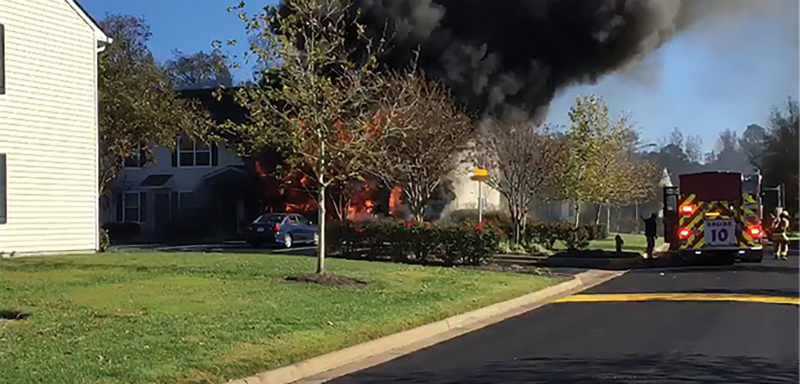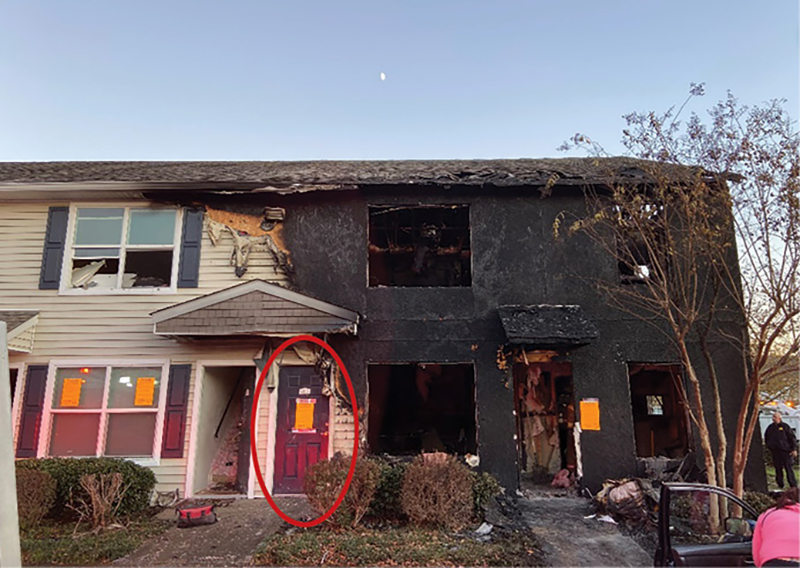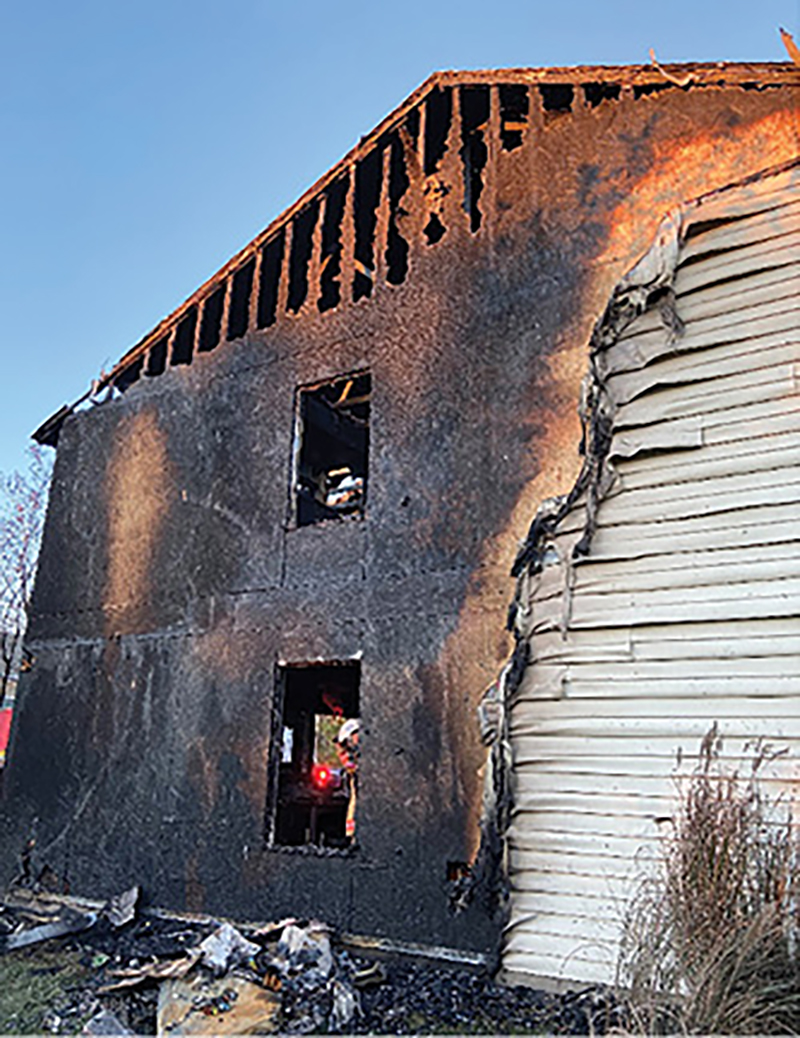WHAT WE LEARNED ❘ By Kevin W. Lyons
On the morning of November 23, 2020, no one at Chesapeake (VA) Fire Department Engine Company 10 would have known that they would be involved in a multiple-rescue apartment fire in a few hours. Engine Company 10 was a four-person company that day. It had been dropped down to a three-person company multiple times in the past because of staffing issues, but today it was four. The driver operator was an eight-year member and a great driver/pumper. The #1 jump seat firefighter was a firefighter/paramedic who was hired on the job at the same time I was. The #2 jump seat firefighter was a rookie with less than two years in the department. I was the officer.
- Rescues at a High-Rise Residential Fire in Virginia
- Tactical Supervision for Known Rescues
- Search Mission Prep: Size-Up, Methods, and Tools
- Rescuers vs. Rescued: Are Our Priorities Backward?
The Incident
The call came out at 1312 hours for an apartment fire with smoke showing from the front of the structure. While responding, we saw a large column of black smoke on the horizon. We called over the radio about what we saw and made it a working incident. After arriving on scene, we had a large two-story apartment complex, end unit, with heavy fire showing from the A and D sides. We had a hydrant in front of the apartment and could establish a water supply. I instructed the two jump seat firefighters to deploy a 2½-inch attack line for an offensive attack and that we would be operating in the offensive strategy. When I opened the door to exit the truck, a retired firefighter who happened to be on the scene told me that I had a victim in the apartment.
I came around the engine and saw an older female citizen on her knees in the parking lot screaming to “get them out!” Walking toward the screaming citizen, I updated responding units about the person trapped and to upgrade the incident to a second alarm. When I got to the citizen, she stated that two of her grandchildren were in the upstairs apartment. I instructed the #2 jump seat firefighter to grab a 1¾-inch attack line off Engine 10 so we could go interior for a rescue. As the #2 jump seat firefighter was getting the hose in place, I was getting myself ready to go interior while talking to the grandmother in an attempt to get an accurate location of where they were located. She stated they were in the back bedroom and that she had tried to go upstairs to get them but the smoke and fire were too hot. She was able to make it to the top of the stairs and yelled for them and they did respond to her when she yelled.

(1) We saw a column of black smoke en route to the scene. [Photos 1-3 by Lt. (Ret.) Michael Urquhart.]

(2) A hydrant was located at the corner of the apartment complex.
Once the #2 firefighter was ready to make entry, we made the push up the stairs to the second-floor apartment. The fire was making its way over the stairway entrance and above us as we entered. It had completely engulfed the downstairs apartment and was also getting into the attic from the D side. We did not encounter any smoke or heat until we reached the top of the stairs. On the second floor, the heat was immense, and the smoke was extremely thick. The entire living room was on fire to the right as we made the top of the stairs.
We conducted a left-hand search to the back bedrooms. As we made the push down the hallway toward the bedrooms, I felt the water hit me from the back and I knew that the #1 jump seat firefighter was getting a good knockdown on the fire with the 2½-inch handline from the outside.
We made the first bedroom on the left side, the door was open, and I instructed the #2 jump seat firefighter to drop the hose so we could search faster, since we had no fire in the bedroom. He went left and I went right. We still could not see anything, and the heat was extreme. We reached the master bedroom and searched above and below. The #2 jump seat firefighter reached the closet and searched it. We searched the bedroom for a few minutes and could not find them.

(3) When we arrived on the scene, we could hear the grandmother screaming to “get them out!”

(4) We entered the second door from the right, which went to the upstairs apartment. (Photos 4-7 by author.)

(5) The A/D corner.

(6) The D side. The fire started downstairs in the kitchen and vented out the window on the D and A sides.
I made my way back to the master bedroom door leading back into the hallway we just came from. I started to panic since we were not finding the girls. Based on the conditions I saw prior to making entry, I knew that we had fire above us in the attic as well as in the apartment below us. I also knew our time to locate the girls was limited. I closed my eyes and took a deep breath to try and calm myself down and think. Once I exhaled, I felt a slight pull in the middle of my shoulders. It was not a jolt but a slight pull. I had never felt anything like this before and have not since. This caused me to turn my head and remember that there are usually two bedrooms in these apartments, right across from each other.
I instructed the #2 jump seat firefighter to continue to search that bedroom and that I was going to continue our left-hand search. I came across another door that was closed. I opened it and still could not see anything. I then heard a girl’s voice saying, “We are right here; help!” I moved my flashlight in the direction of the voice and the girl ran to me, wrapping her arms around me. I yelled to the #2 jump seat firefighter that I had found them and to come straight across from the other bedroom. Within a few seconds, he had found us, and I handed the girl to him and instructed him to go out the same way we came in. I also reminded him to follow the hoseline back out.
The heat conditions had improved tremendously at this point from the 2½-inch hose attacking from the exterior. I knew the fastest way to get them out was to go out the same way we came in. Once the #2 firefighter left with the first girl, I turned around and found the second girl lying on the ground at my feet. I picked her up and carried her out the same way we came in. She was semiconscious but whispered that she could not breathe. I told her to hold on and that we were almost outside. We made it down the stairs and out to the grandmother, who was anxiously waiting. She was so excited and relieved that we had got them out safe. She thanked us numerous times while we assisted them to the awaiting medic units for medical evaluation and transport to the local hospital.

(7) The second-floor window at the corner is where we found the girls. This is the C/D side.
Figure 1. The Search

We came up the entry stairs and started the left-hand search. The living and dining rooms were on fire and so was the kitchen. When we conducted the left-hand search, we hit the master bedroom on the left first. We searched it, including the walk-in closet, and could not find the girls. I then went across the hallway and found the girls in the second bedroom.
We had successfully rescued the seven- and 11-year-old sisters from the apartment fire. The following day, we found out that the girls had been discharged from the hospital. Their only issue from this fire was high carbon monoxide levels from smoke inhalation. They had no burns and no other traumatic injuries. This rescue was accomplished by the teamwork, skill, bravery, courage, and professionalism of all the members of Engine Company 10.
Lessons Learned
Following are lessons learned from this incident.
Staffing. A frequent problem in the fire service today is having an adequate number of personnel to staff apparatus to their full potential. On this day, we were lucky to have our normal four-member engine. If we had to drop the engine down to a three-person crew, it would have changed the entire tactical approach to this fire. It is very important to know what limitations your crew faces if staffing affects how you will typically operate on a fire scene. This needs to be considered every morning once staffing is completed.
Rescue. Being part of a rescue is one of the most unique and stressful situations for any firefighter. It is important to keep yourself and your crew calm and make sure the scene is set up for success. The first-arriving apparatus will set the tone for the entire scene. If a crew sets the tone with a calm and efficient size-up and proper tactics, the scene will run a lot smoother from start to finish.
Familiarize yourself with structures on EMS responses. Observe how structures are constructed while responding to EMS calls. Taking a good look around the structure and visualizing how it is set up are very important if visibility is limited or nonexistent in a fire. This will give members a good understanding and a basic layout of the building when they can see it clearly. This helped in the rescue of the girls because we had a good basic layout in our heads. This assisted in a rapid search and rescue operation.
Gather information from family/bystanders. If there are family members on scene, they are the best source of rapid and effective information to make better decisions. The grandmother knew exactly where her grandchildren were, and she had heard them screaming just a few minutes before we made entry. Crews can gather a lot of information in a short amount of time when family members are on scene. The family will often be very emotional and screaming uncontrollably, but asking them questions helps to calm them down and give valuable information to assist in a rescue.
Search techniques. Conducting a rapid and detailed search is also a very important aspect of any fire scene and rescue. We conducted a left-hand search because a right-hand search would have led us to the living room and where part of the fire was located. The #2 jump seat firefighter was at the nozzle, and I was behind him assisting in searching with my thermal imaging camera while also dragging the hose upstairs and around the apartment. We could not see each other at all, but we stayed in constant communication so we knew each other’s location and that we were still OK while pushing forward. When we made the first bedroom, I made the decision to not take the hoseline into the bedroom because it would slow down the search and there was no fire except behind us. This allowed us to complete our search faster and more effectively.

(8) We placed the 2½-inch line in service on the A side of the structure, operated by one firefighter. Once other crews arrived on scene, they assisted in operating the line. [Photo by Lt. (Ret.) Michael Urquhart.]
Higher power inside. While we were inside the apartment looking for the girls, I had an experience I will never forget. When we had conducted our search in the first bedroom and could not find the girls, I started to panic. I knew that the girls should be in there because the grandmother just spoke to them. I closed my eyes and took a deep breath. I learned to do this in the fire academy when I was starting to stress out or become entangled in a training evolution. I let it out and, with my eyes still closed, I felt a pull on the middle of my shoulders. It was very slight but enough for me to open my eyes and turn my head to the right. I remembered there was a second bedroom in the apartment. Once I remembered that, I told the #2 jump seat firefighter my intentions and once I found and opened the door, that’s when I found the girls. To this day, I still feel that pull between my shoulders.
Often, your gut feeling or intuition is triggered by taking the time, slowing down, and trusting your senses. When you have these feelings, you should not ignore them. They are there for a reason, and it is sometimes difficult to explain. It could be you are subconsciously recalling something that was already there or, in some cases, it could be divine intervention from a higher power.
Closed hollow core door protection. This incident is proof that a residential hollow core door will keep a lot of heat from entering any room. The girls saved their own lives by closing the door to their bedroom. This kept that immense heat that we felt at the top of the steps out of their room and allowed them to survive this ordeal. When we attend any school function, we make sure to share our story with the students and the importance of closing their bedroom doors at night in case of fire. This will keep them safer longer so firefighters can rescue them if they cannot get out on their own.
Upgrading to a second alarm. Another important aspect of any rescue is the number of resources responding. If there is any doubt on having the appropriate number, it’s best to upgrade to a second or third alarm to ensure the incident does not get out of hand. The mindset is to start the additional companies coming early; you can always turn them around. This played a large part in the success of this fire.
Proper PPE donning. One of the most basic and important skills that a firefighter can become proficient in is properly donning gear. The #2 jump seat firefighter learned this the hard way at this fire. When he was expediting putting the 1¾-inch line in service and getting his gear on correctly, he had forgotten to put his wrist though his wristlets. When he was performing search techniques, he laid down in the closet to try and cover as much ground as he could. When he did this, his arms stretched out from his coat and heat entered the top of his hands; he ended up receiving second-degree burns on both hands. This is a reminder to train on properly donning firefighting gear. When practiced regularly, it will become second nature.
Rookie training important after academy. One of the best things a company can do is to invest time and energy training rookies and getting them as much experience on the job as possible. This incident is the perfect example of training rookies to their fullest potential. The #2 jump seat firefighter had only been on the streets for about a year before this large and stressful incident. He kept his composure and accomplished the tasks that were given to him in a professional and courageous manner. Taking time to see the strengths and weaknesses of your rookies is very important to help the team mold them into productive and team-driven firefighters everyone wants to work with.
Apparatus placement for aerial as well as Engine 10 placement. The apparatus placement at any fire is important. We could not pull up to see at least three sides of the structure like a normal first-arriving unit would do on a residential structure fire. Since this was an apartment complex, we could only see two sides. Our hydrant was at the corner of the apartment that was on fire, so establishing a water supply was simple. We staged on the main road outside the parking lot so that a ladder or water tower could turn into the parking lot and set up in case the fire went defensive. Most apparatus would normally place themselves in front of the building on fire, but the fire could only travel in one direction, so we left the parking lot available for a ladder or water tower.
Kevin W. Lyons is a lieutenant/EMT-A for the Chesapeake (VA) Fire Department with 15 years of fire service experience. He has an associate degree in business administration and fire science and a bachelor’s in business management and is working on his master’s in business administration with a focus in public administration. He is also a veteran of the U.S. Coast Guard, where he served for 13 years.

